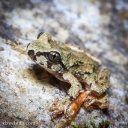 |
Coastal Tailed Frog Range Map

|
|
|
 |
 |
 |
 |
 |
 |
 |
Coastal Tailed Frog Video
|
|
|
 |
 |
 |
 |
 |
 |
|
Coastal Tailed Frog (Ascaphus truei)
Description: Since tailed frogs spend their life in association with fast-flowing streams, they have evolved some morphological adaptations that stand out from other frogs and toads. For example, the lungs are greatly reduced, presumably to control buoyancy, and the toe tips are hard and keratinized, to facilitate crawling among rocks on the stream bottom.
Juveniles and adults are small, typically ranging from under 1-inch to 2.5 inches in snout-vent length. Overall, color is usually comparable to the tailed frog’s substrate and may vary from tan to chocolate brown or olive green. Regardless of the color, its skin has a characteristic rough feel. Moreover, the head is comparatively large and flattened with a light triangular-shaped mark generally present between the snout and eyes. The eyes themselves have visibly vertical pupils, and a dark stripe extends from the snout to the shoulder. Some more obvious adaptations to its streamside habitat include a slight webbing of the toes, with the outer hind toes also flattened. In addition, they lack tympani or ear membranes and, as a result, lacks the capacity to communicate acoustically, a likely adaptation to the steady sound of flowing water. Tailed frogs get their common name from another aquatic adaptation: males have a short, tail-like copulatory organ used during internal fertilization. Tailed frogs exhibit additional sexual dimorphism in that males are smaller than females, and they develop black, horny pads on the insides of their thighs during the mating season to aid gripping females during amplexus.
Tadpoles average little more than 11 mm after hatching, but may grow to 2.5 inches in length before metamorphosis. Initially, hatchlings have no color, but are instead identified according to the presence of a prominent yolk sac seen in the abdomen. However, tadpoles eventually take on a black to brownish-grey coloration of the body that is covered with black speckling. A white dot discernible on the tip of the tail and an obvious copper-colored bar between the eyes and snout are additional field marks for identification. Tailed frog tadpoles also have some adaptations to keep from being swept away by stream currents. The body is flattened ventrally and the tail is laterally compressed. Moreover, the mouth has evolved into an oral disc that is sucker-like, allowing for attachment to rocks. Eggs are unpigmented and are laid in a gelatinous string beneath a rock in shallow water
Habitat: Tailed frogs inhabit clear, cold streams of mountainous regions with step-pools, such that the slope is neither too shallow nor too steep. They inhabit a wide range of elevations from coastal to mountainous. Stream temperatures must remain cool even in summer months, as this species is known to have narrow temperature tolerances. Also, coarse substrates are favored for egg-laying and over-wintering events. As larvae do exhibit a long developmental period, stream habitats must be permanent features of the landscape. Juveniles and adults, however, further require the presence of a mature or old growth forest alongside their stream habitat. While they will not venture too far from the water, juveniles and adults will utilize riparian vegetation for food and refuge. This vegetation is also important to larvae, as it helps to control stream temperatures and prevent excessive sedimentation through bank stabilization.
Range: The range of this frog in California is from near Anchor Bay, Mendocino county, north along the coast to the Oregon Border and as far east as near Big Bend, Shasta County.
The species ranges farther north through the Cascades Mountains of Oregon and Washington and along the north coast of British Columbia, almost to Alaska.
Diet: Adults and juveniles eat a wide variety of invertebrates, whatever is in season. Adults feed along stream banks and in the nearby forest at night and sometimes during daylight. Tadpoles emerge at night to forage on rocks. They sometimes crawl up onto rocks out of the water, probably to feed. Tadpoles have been found with ingested diatoms, algae, and desmids, and conifer pollen in their guts.
Reproduction: Tailed frogs are unique among the anurans in exhibiting a combination of amplexus and copulation during courtship and mating. Courtship occurs at the onset of fall, between September and October, and is carried out in the water. During courtship, a male typically lunges or swims suddenly toward a female of the same species. Clasping the female’s body directly anterior to her pelvic region, the male may then perform either inguinal or ventral amplexus. Once in the proper position, copulation can follow, the male's erect “tail” inserted into the female’s cloaca. To press closer to the female during copulation, the male may repeatedly produce thrusts of his pelvic region, his “tail” still within the cloaca.
Status: Tailed Frogs are extremely sensitive to warm temperatures. Tailed Frog populations may be severely reduced as a result of the sedimentation and warming of streams caused by timber harvesting and road building, but there is no published evidence of a broad scale decline. Globally Ascaphus truei is cited as a species of Least Concern. In Washington, the species is marked as apparentlys eciure. In California the species is marked as Species of Special Concern, and inOregon the species is marked as Vulnerable.
Subspecies: None
»» Kingdom: Animalia - Animals
»» Phylum: Chordata - Chordates
»» Subphylum: Vertebrata - Vertebrates
»» Class: Amphibia - Amphibians
»» Order: Anura - Frogs & Toads
»» Family: Ascaphidae - Tailed Frogs
»» Genus: Ascaphus
»» Species: Ascaphus truei - Coastal Tailed Frog
»» Subspecies: None
This article uses material from the Wikipedia article "Tailed frog", which is released under the Creative Commons Attribution-Share-Alike License 3.0. Content may have been omitted from the original, but no content has been changed or extended.
|
|






